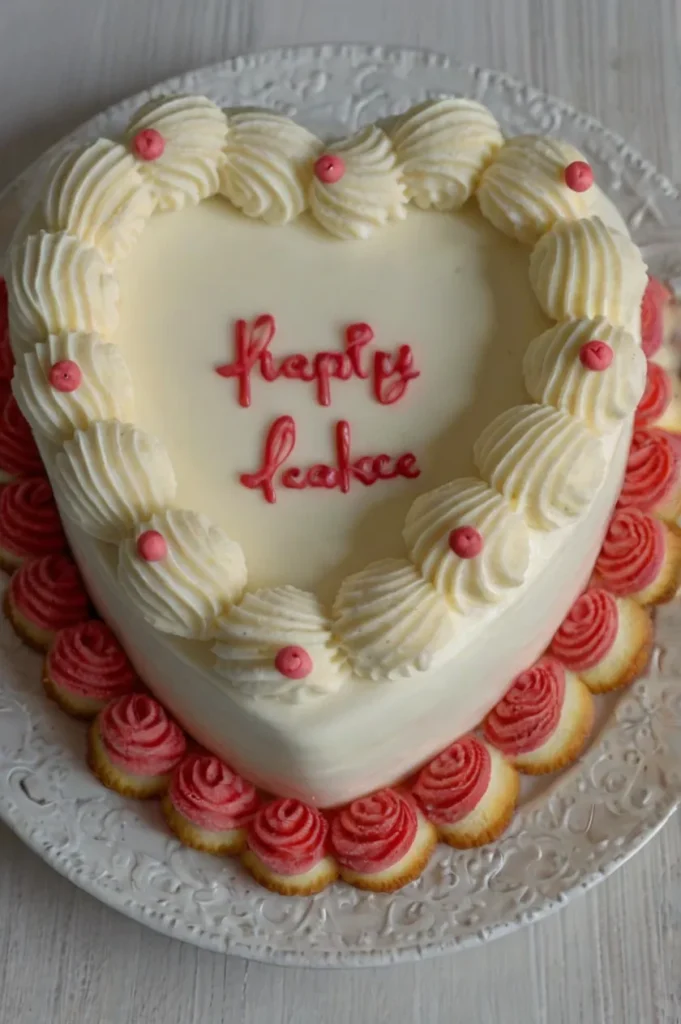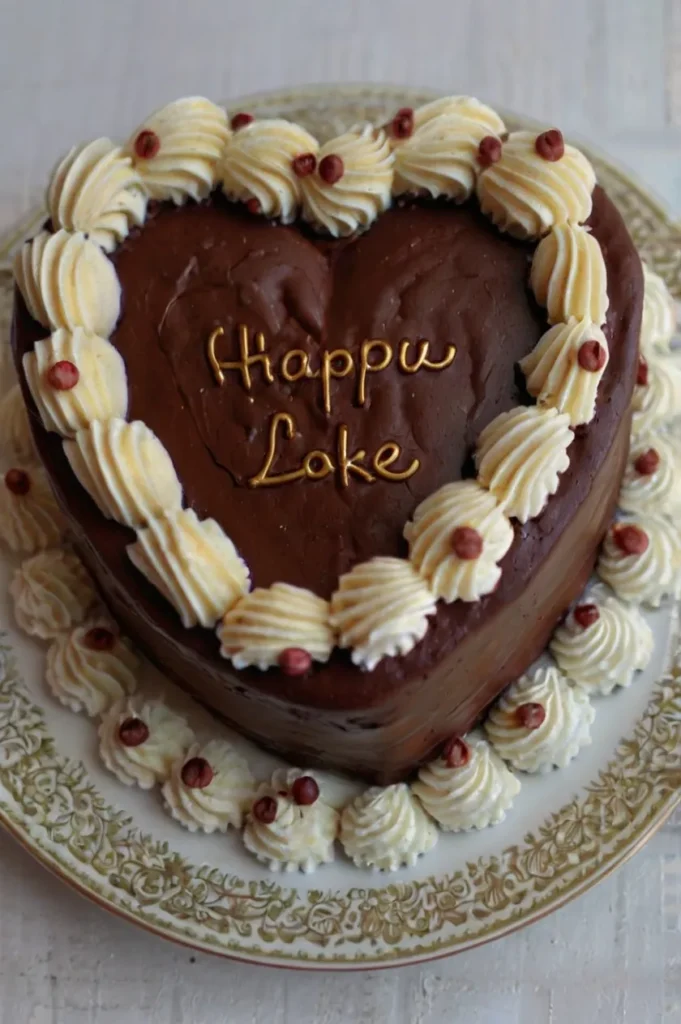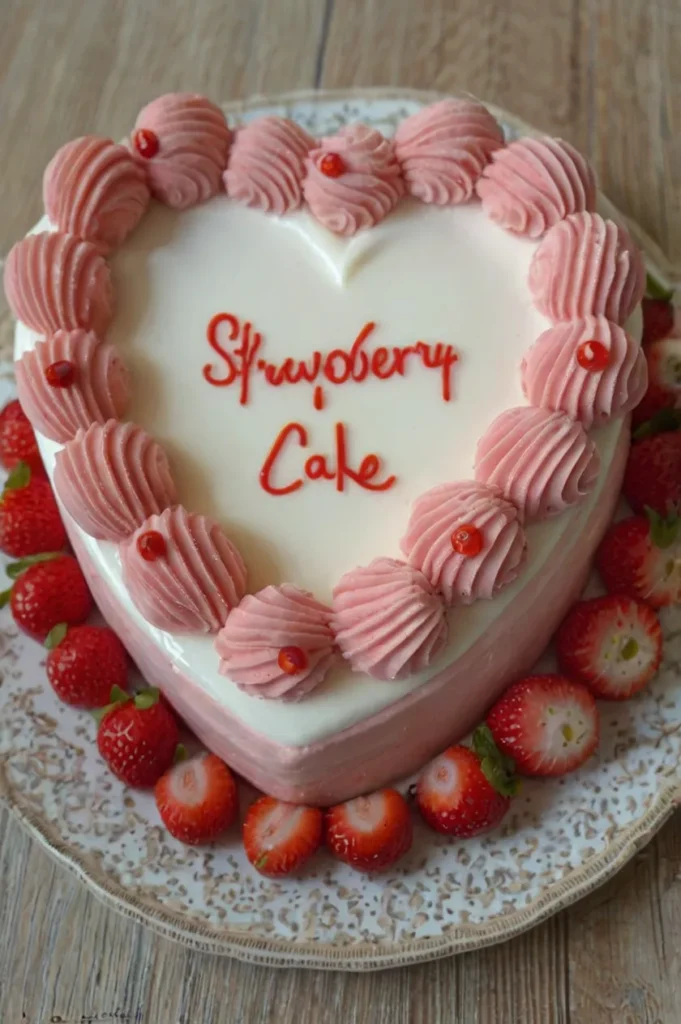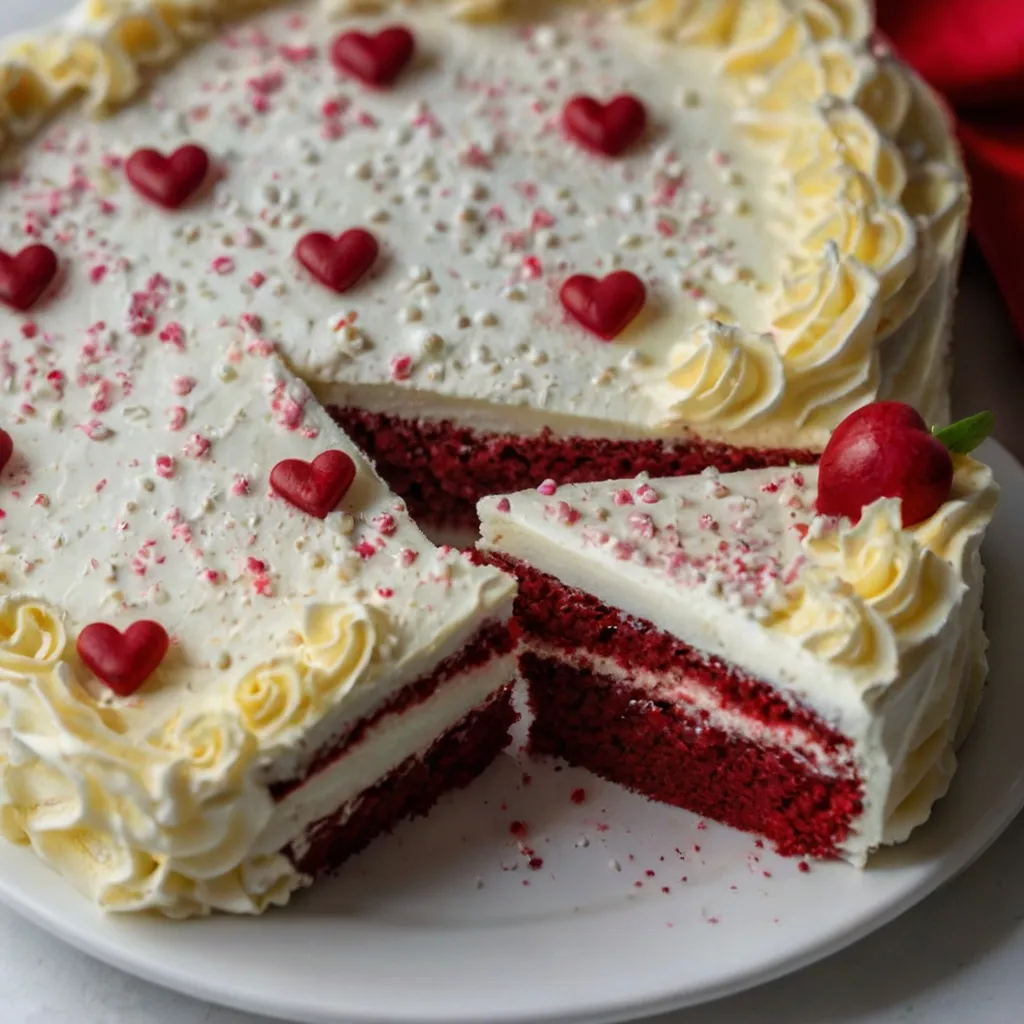The Best Guide to Heart Cakes: Delicious Recipes, Techniques, and Decoration Ideas
Discover stunning heart cake designs perfect for Valentine’s Day, anniversaries, or special occasions. Get inspired with creative decorating ideas and tips to make your own heart cake
There’s something undeniably special about a heart-shaped cake. Whether it’s for Valentine’s Day, an anniversary, or simply to show someone you care, a heart cake speaks volumes without saying a word. In this comprehensive guide, we’ll explore everything you need to know about creating stunning heart cakes that not only look beautiful but taste amazing too.
What is a Heart Cake?
A heart cake is exactly what it sounds like—a cake shaped like a heart! But it’s so much more than just its shape. A heart cake represents love, affection, and celebration. While the exterior form captures immediate attention, the real magic happens when you combine the perfect cake recipe with creative decorating techniques to create a dessert that’s as delicious as it is meaningful.
content overview
Table of Contents
Why Make a Heart Cake?
Heart cakes are versatile celebrations of love and connection. They’re perfect for:
- Valentine’s Day celebrations
- Anniversaries and wedding celebrations
- Engagement parties
- Mother’s Day or Father’s Day
- Birthday celebrations for someone special
- “Just because” moments to show someone you care
- Bridal showers and bachelor/bachelorette parties
The beauty of heart cakes lies in their symbolism—they’re an edible expression of love that brings joy to both the baker and the recipient.
Discover more cakes Recipes
A Brief History of Heart-Shaped Desserts
Heart-shaped desserts have a rich history dating back centuries. The heart symbol itself has been associated with love since ancient times, but it wasn’t until the Middle Ages that heart-shaped confections began appearing in European courts. By the Victorian era, heart-shaped chocolates and cakes had become popular tokens of affection.
The modern heart cake gained significant popularity in the mid-20th century, coinciding with the commercialization of Valentine’s Day. Today, heart cakes continue to evolve with innovative designs, flavors, and decorating techniques that push the boundaries of baking artistry.
Heart Cake Basics
Essential Ingredients
Creating the perfect heart cake starts with understanding your ingredients. Each component plays a crucial role in the cake’s texture, flavor, and structure.
Flour
- All-purpose flour: The standard choice for most cake recipes, with a moderate protein content (10-12%) that provides good structure.
- Cake flour: Lower in protein (7-9%), resulting in a more tender, delicate crumb—ideal for lighter cakes.
- Self-rising flour: Contains baking powder and salt already mixed in; convenient but less control over leavening.
Sweeteners
- Granulated sugar: Provides sweetness and helps create a fine, tender crumb by aerating the batter when creamed with butter.
- Brown sugar: Adds moisture and a subtle molasses flavor, perfect for richer cakes.
- Powdered sugar: Used primarily in frostings for a smooth texture.
- Alternative sweeteners: Honey, maple syrup, or coconut sugar can add unique flavors but may require recipe adjustments.
Fats
- Butter: Adds rich flavor and helps create a tender crumb when creamed with sugar.
- Oil: Creates an exceptionally moist cake with a softer texture than butter-based cakes.
- Shortening: Produces a very tender crumb and stable frosting, though it lacks flavor.
Leavening Agents
- Baking powder: A complete leavening agent that works once when moistened and again when heated.
- Baking soda: Needs an acidic ingredient (like buttermilk or yogurt) to activate; produces a more tender crumb.
- Eggs: Provide structure, moisture, and natural leavening when whipped.
Liquids
- Milk: Adds moisture and creates a tender crumb.
- Buttermilk: Adds tanginess and reacts with baking soda for extra lift.
- Sour cream/yogurt: Creates a moist, tender cake with subtle tang.
Flavorings
- Vanilla extract: The foundation of many cake flavors; use pure extract for best results.
- Citrus zest: Adds bright, fresh flavor without additional moisture.
- Spices: Cinnamon, nutmeg, and cardamom add warmth and complexity.
- Chocolate: Available as cocoa powder (Dutch-processed or natural) or melted chocolate.
Tools and Equipment
Having the right tools makes baking heart cakes easier and more enjoyable.
Heart-Shaped Pans
- Dedicated heart pans: Available in various sizes, from mini heart molds to large celebration cakes.
- Creating heart shapes without special pans: Use a round pan and a square pan, cut the round cake in half, and position the halves on two sides of the square to form a heart.
Mixing Equipment
- Stand mixer: Ideal for thorough creaming and consistent results.
- Hand mixer: A more affordable and space-saving alternative.
- Mixing bowls: Having multiple sizes allows you to prepare different components simultaneously.
- Silicone spatulas: Essential for folding and scraping down bowl sides.
Decorating Tools
- Offset spatulas: For smooth frosting application.
- Bench scraper: Creates clean sides on frosted cakes.
- Piping bags and tips: For creating decorative borders, flowers, and writing.
- Cake turntable: Makes frosting and decorating much easier.
- Cardboard cake rounds: Provide support when moving cakes.
Additional Equipment
- Cooling racks: Essential for proper cooling to prevent soggy bottoms.
- Cake leveler or serrated knife: For creating even layers.
- Digital kitchen scale: For precise measurements, especially important in baking.
- Instant-read thermometer: Helps determine when cakes are perfectly done.
Baking Techniques
Mastering these techniques will ensure your heart cake has the perfect texture and flavor.
Mixing Methods
- Creaming method: Beating butter and sugar until light and fluffy incorporates air for a tender crumb.
- Reverse creaming: Mixing dry ingredients with butter before adding liquids creates a velvety texture.
- All-in-one method: Combining all ingredients at once; convenient but generally produces a denser cake.
- Folding: Gently incorporating ingredients to maintain air bubbles, especially important for whipped egg whites.
Temperature Considerations
- Room temperature ingredients: Allow butter, eggs, and dairy to reach room temperature for proper incorporation and emulsion.
- Oven temperature: Use an oven thermometer to verify accuracy; most cakes bake between 325°F and 350°F.
- Preheating: Always preheat your oven thoroughly before baking.
Testing for Doneness
- Toothpick test: Insert a toothpick into the center—it should come out clean or with a few moist crumbs.
- Spring-back test: Gently press the center of the cake; it should spring back when fully baked.
- Internal temperature: Most cakes are done when they reach 205-210°F internally.
Heart Cake Recipes
Classic Vanilla Heart Cake
This timeless recipe creates a moist, flavorful vanilla cake that serves as the perfect canvas for any decoration.

Ingredients:
- 3 cups cake flour
- 1 tablespoon baking powder
- ½ teaspoon salt
- 1 cup (2 sticks) unsalted butter, room temperature
- 2 cups granulated sugar
- 4 large eggs, room temperature
- 2 teaspoons pure vanilla extract
- ½ teaspoon almond extract (optional)
- 1 cup whole milk, room temperature
Instructions:
- Preheat oven to 350°F. Grease and flour two 9-inch heart-shaped pans.
- Whisk together flour, baking powder, and salt in a medium bowl.
- In a stand mixer, cream butter and sugar until light and fluffy, about 5 minutes.
- Add eggs one at a time, beating well after each addition.
- Stir in vanilla and almond extracts.
- Alternate adding flour mixture and milk, beginning and ending with flour (3 additions of flour, 2 of milk).
- Divide batter between prepared pans and smooth tops.
- Bake for 25-30 minutes until a toothpick inserted comes out clean.
- Cool in pans for 10 minutes, then transfer to wire racks to cool completely.
Variations:
- Add ¼ cup sprinkles for a funfetti heart cake
- Replace ¼ cup of milk with sour cream for extra moisture
- Add 1 tablespoon lemon zest for a subtle citrus note
Rich Chocolate Heart Cake
This decadent chocolate cake is perfect for true chocolate lovers.

Ingredients:
- 2 cups all-purpose flour
- 2 cups granulated sugar
- ¾ cup Dutch-processed cocoa powder
- 2 teaspoons baking soda
- 1 teaspoon baking powder
- 1 teaspoon salt
- 2 large eggs
- 1 cup buttermilk
- ½ cup vegetable oil
- 2 teaspoons vanilla extract
- 1 cup hot coffee or hot water
Instructions:
- Preheat oven to 350°F. Grease and line two 9-inch heart-shaped pans.
- In a large bowl, whisk together dry ingredients.
- Add eggs, buttermilk, oil, and vanilla; beat on medium speed for 2 minutes.
- Stir in hot coffee/water (batter will be thin).
- Pour into prepared pans and bake for 30-35 minutes.
- Cool completely before frosting.
Serving suggestion: Pair with raspberry filling and chocolate ganache for an indulgent treat.
Strawberry Heart Cake
Fresh and fruity, this cake is perfect for spring celebrations.

Ingredients:
- 2¾ cups cake flour
- 1 tablespoon baking powder
- ½ teaspoon salt
- 1 cup unsalted butter, room temperature
- 1¾ cups granulated sugar
- 5 large egg whites, room temperature
- ⅓ cup sour cream
- 2 teaspoons vanilla extract
- ½ cup whole milk
- ½ cup reduced strawberry purée (from 1½ cups fresh strawberries)
- Few drops of pink food coloring (optional)
Instructions:
- Blend fresh strawberries, then simmer the purée until reduced by half. Cool completely.
- Preheat oven to 350°F. Prepare heart-shaped pans.
- Whisk dry ingredients together.
- Cream butter and sugar until light and fluffy.
- Beat in egg whites, then sour cream and vanilla.
- Alternatively, add dry ingredients and milk.
- Fold in cooled strawberry purée and optional food coloring.
- Bake for 25-30 minutes until done.
Perfect pairing: Cream cheese frosting with fresh strawberry slices between layers.
Red Velvet Heart Cake
A classic choice for Valentine’s Day with its dramatic color and subtle chocolate flavor.

Ingredients:
- 3 cups cake flour
- 1 teaspoon baking soda
- 2 tablespoons unsweetened cocoa powder
- ½ teaspoon salt
- ½ cup unsalted butter, room temperature
- 2 cups granulated sugar
- 1 cup vegetable oil
- 4 large eggs, room temperature
- 1 tablespoon vanilla extract
- 1 teaspoon distilled white vinegar
- 2-3 tablespoons red food coloring
- 1 cup buttermilk, room temperature
Instructions:
- Preheat oven to 350°F. Prepare heart-shaped pans.
- Whisk together dry ingredients.
- Beat butter and sugar until light and fluffy, then add oil.
- Add eggs one at a time, then vanilla, vinegar, and food coloring.
- Alternatively, add dry ingredients and buttermilk.
- Bake for 25-30 minutes until done.
Traditional pairing: Classic cream cheese frosting.
Lemon Heart Cake
Bright and zesty, this cake brings sunshine to any celebration.

Ingredients:
- 3 cups cake flour
- 2½ teaspoons baking powder
- ½ teaspoon baking soda
- ½ teaspoon salt
- 1 cup unsalted butter, room temperature
- 2 cups granulated sugar
- 4 large eggs, room temperature
- ¼ cup fresh lemon juice
- 2 tablespoons lemon zest
- 1 teaspoon vanilla extract
- 1 cup buttermilk, room temperature
Instructions:
- Preheat oven to 350°F. Prepare heart-shaped pans.
- Whisk dry ingredients together.
- Cream butter and sugar until very light and fluffy.
- Add eggs one at a time, then lemon juice, zest, and vanilla.
- Alternatively, add dry ingredients and buttermilk.
- Bake for 25-30 minutes until done.
Perfect pairing: Lemon curd filling with Swiss meringue buttercream.
Frosting and Decoration Guide
Buttercream Frosting
American Buttercream
The simplest frosting, made with butter and powdered sugar.
Basic Recipe:
- 1 cup unsalted butter, softened
- 4 cups powdered sugar, sifted
- 2-3 tablespoons heavy cream or milk
- 2 teaspoons vanilla extract
- Pinch of salt
Method:
Discover more cakes Recipes
- Beat butter until creamy and pale.
- Gradually add powdered sugar on low speed.
- Add vanilla and salt.
- Add cream gradually until the desired consistency is reached.
- Beat on high speed for 3-5 minutes until light and fluffy.
Tips:
- For chocolate buttercream, add ½ cup cocoa powder
- For fruit-flavored buttercream, replace some of the cream with fruit reduction
- For stability in warm weather, replace up to half the butter with shortening
Swiss Meringue Buttercream
Silky smooth and less sweet than American buttercream.
Basic Recipe:
- 5 large egg whites
- 1 cup granulated sugar
- Pinch of salt
- 1½ cups unsalted butter, room temperature but still slightly cool
- 1 tablespoon vanilla extract
Method:
- Heat egg whites and sugar in a double boiler, whisking constantly until sugar dissolves and mixture reaches 160°F.
- Whip the mixture until stiff, glossy peaks form and the bowl feels cool to the touch.
- Add butter a tablespoon at a time, beating well after each addition.
- Add vanilla and salt, continue beating until smooth.
Troubleshooting:
- If the mixture looks curdled, continue beating—it will come together
- If too soft, refrigerate for 15 minutes, then beat again
- If too firm, gently warm the bowl and beat again
Italian Meringue Buttercream
The most stable meringue buttercream, ideal for warmer weather.
Basic Recipe:
- 1 cup granulated sugar
- ¼ cup water
- 5 large egg whites
- ¼ teaspoon cream of tartar
- 1½ cups unsalted butter, slightly cool but malleable
- 1 tablespoon vanilla extract
Method:
- Cook sugar and water to 240°F (soft ball stage).
- Meanwhile, whip egg whites with cream of tartar to soft peaks.
- With mixer running, slowly pour hot syrup into whites and continue beating until cool.
- Add butter a tablespoon at a time, then vanilla.
Ganache
A luxurious chocolate topping or filling made from chocolate and cream.
Dark Chocolate Ganache
Recipe:
- 8 ounces high-quality dark chocolate (60-70% cocoa)
- 1 cup heavy cream
- 1 tablespoon unsalted butter (optional, for shine)
Method:
- Chop chocolate finely and place in a heat-proof bowl.
- Heat cream to just below a boil.
- Pour over chocolate and let stand 1 minute.
- Stir gently until smooth, and add butter if using.
- For pouring consistency, use while warm.
- For spreading/piping, cool until thickened.
White Chocolate Ganache
Recipe:
- 12 ounces white chocolate
- ¾ cup heavy cream
- 1 tablespoon unsalted butter (optional)
Method: Same as dark chocolate, but note that white chocolate is more sensitive to heat.
Variations:
- Add 1-2 tablespoons liqueur after mixing
- Infuse cream with herbs, spices, or tea before heating
- Add food coloring for colored ganache drips
Cream Cheese Frosting
Tangy and perfect for red velvet or carrot cakes.
Recipe:
- 8 ounces cream cheese, room temperature
- ½ cup unsalted butter, room temperature
- 4 cups powdered sugar, sifted
- 1 teaspoon vanilla extract
- Pinch of salt
Method:
- Beat cream cheese and butter until smooth and combined.
- Gradually add powdered sugar on low speed.
- Add vanilla and salt, beat until fluffy.
Tips:
- Keep refrigerated until ready to use
- For piping, use slightly more butter for stability
- Add 1 tablespoon of cornstarch to help stabilize for warm weather
Fondant
Perfect for smooth finishes and detailed decorations.
Working with Store-Bought Fondant:
- Knead until pliable.
- Roll to ⅛-inch thickness on surface dusted with powdered sugar or cornstarch.
- Lift carefully with a rolling pin and drape over the cake.
- Smooth with fondant smoothers from the center outward.
- Trim excess with a sharp knife.
Tips:
- Apply a thin layer of buttercream before fondant for adhesion
- For colored fondant, knead in gel food coloring gradually
- Keep unused fondant wrapped in plastic to prevent drying
- For heart shapes, cut fondant with cookie cutters for decorations
Piping Techniques
Master these techniques to create beautiful decorations.
Basic Borders
- Shell Border: Apply pressure, push forward slightly, stop pressure, and pull away.
- Rope Border: Pipe at a 45° angle, applying even pressure in a continuous motion.
- Dot Border: Simple dots piped along the edge at even intervals.
Roses
- Start with a small cone of buttercream for the center.
- Using the petal tip (104), pipe overlapping petals around the center.
- Start with tight petals, gradually make them looser as you work outward.
- For a complete tutorial, check out our video guides on the website.
Writing on Cakes
- Practice on parchment paper first.
- Use a round tip (#2 or #3).
- Apply consistent pressure for even lettering.
- For the script, maintain a fluid motion without stopping.
Sprinkles and Edible Decorations
The finishing touches that add personality to your cake.
Types of Sprinkles:
- Nonpareils: Tiny colored balls
- Jimmies: Thin rod-shaped sprinkles
- Confetti Sprinkles: Flat discs in various shapes
- Dragées: Metallic sugar balls (note: some metallic varieties are for decoration only)
- Sanding Sugar: Coarse, sparkly sugar
Application Techniques:
- For sides of cakes: Press sprinkles into frosting while still soft
- For targeted application: Use a small spoon or even tweezers
- For even distribution, mix some types into the frosting
Edible Decorations:
- Edible gold and silver leaf
- Chocolate curls and shavings
- Fondant cutouts
- Sugar flowers
- Crystallized flowers
Vintage Heart Cake Decorations
Create nostalgic, charming designs with these classic techniques.
- Piped Lace: Use a small round tip to create delicate patterns inspired by doilies.
- Royal Icing Strings: Fine lines piped in patterns across the cake.
- Buttercream Rosebuds: Small, simple roses arranged in clusters or garlands.
- Cameos: Create Victorian-inspired silhouettes with fondant and food coloring.
- Brush Embroidery: Use a small brush to feather out royal icing for delicate flower designs.
Advanced Techniques
Take your heart cakes to the next level with these sophisticated methods.
Ombre Frosting
A gradient effect that transitions from light to dark.
Method:
- Divide frosting into 3-4 portions.
- Tint each portion progressively darker shades of the same color.
- Apply the darkest shade to the bottom of the cake, the medium shade to the middle, and the lightest to the top.
- Blend where colors meet with a clean spatula, scraping and smoothing until the transition is seamless.
Fault Line Cakes
Create a “geological fault” effect with a peek-through design.
Method:
- Frost cake with base color buttercream.
- Apply a wide strip of contrasting color or pattern (sprinkles, metallic, etc.) around the middle.
- Frost the top and bottom with base color again, extending slightly over the middle section.
- Clean edges to create a crisp line that reveals the middle section.
Stenciling
Create precise patterns with minimal artistic skill required.
Method:
- Apply a smooth layer of buttercream and allow to crust slightly.
- Hold stencil firmly against the surface.
- Apply contrasting color buttercream or edible dust over stencil with offset spatula or sponge.
- Carefully remove the stencil to reveal the pattern.
Edible Flowers
Add a natural, elegant touch with real blooms.
Safe Edible Flowers:
- Roses (unsprayed)
- Violets
- Pansies
- Nasturtiums
- Lavender
Method:
- Use only organically grown, pesticide-free flowers.
- Wash and dry flowers thoroughly.
- For indirect contact with cake, wrap stems in floral tape.
- For direct placement on frosting, consider placing small pieces of parchment underneath.
Drip Cakes
A modern, artistic technique with stunning visual impact.
Method:
Discover more cakes Recipes
- Frost cake with smooth buttercream and chill until firm.
- Prepare ganache to pouring consistency (slightly warm).
- Pour a small amount of ganache in the center of the cake top.
- Gently push to edges with offset spatula, allowing some to drip down sides.
- For controlled drips, use a squeeze bottle or spoon to place drips individually.
Troubleshooting
Common Problems and Solutions
Dry Cake
Causes:
- Overbaking
- Too much flour
- Not enough fat or sugar
Solutions:
- Use a timer and check for doneness early
- Measure flour by spooning into cups, then leveling off
- Add simple syrup to finished cake layers for moisture
Sunken Cake
Causes:
- Underbaking
- Opening the oven door too early
- Expired leavening agents
Solutions:
- Ensure the cake is fully baked before removing from the oven
- Don’t open the oven during the first 75% of the baking time
- Test baking powder/soda freshness before use
Cracked Frosting
Causes:
- Buttercream too cold
- Cake layers shifting
- Air bubbles in frosting
Solutions:
- Let buttercream come to room temperature before using
- Secure layers with dowels for taller cakes
- Smooth frosting firmly, pressing out air bubbles
Bulging Sides
Causes:
- Filling too soft
- Too much filling
- Weight of top layers
Solutions:
- Use a thicker consistency for fillings
- Create a buttercream dam around the edges before filling
- Chill layers before stacking
Tips and Tricks
Baking at High Altitude
If you’re above 3,000 feet in elevation, make these adjustments:
- Increase oven temperature by 25°F
- Decrease sugar by 1-2 tablespoons per cup
- Increase liquid by 2-4 tablespoons per cup
- Decrease leavening by ¼ teaspoon per teaspoon
Vegan/Gluten-Free Adaptations
Vegan Heart Cake:
- Replace eggs with flax eggs (1 tablespoon ground flaxseed + 3 tablespoons water = 1 egg)
- Use plant-based milk and butter alternatives
- Consider adding extra leavening for structure
Gluten-Free Heart Cake:
- Use high-quality 1-to-1 gluten-free flour blend
- Add ¼ teaspoon xanthan gum if your blend doesn’t include it
- Let batter rest 30 minutes before baking to hydrate the flour
Make-Ahead Tips
Cake Layers:
- Bake up to 1 month ahead and freeze, wrapped tightly in plastic wrap and foil
- Thaw in refrigerator overnight before decorating
Frostings:
- American buttercream: Make up to 1 week ahead, refrigerate, bring to room temperature, and re-whip
- Swiss/Italian meringue: Make up to 1 week ahead, refrigerate, bring to room temperature,e and re-whip
- Ganache: Make up to 3 days ahead, refrigerate, and rewarm gently
Fully Decorated Cakes:
- Most cakes can be fully decorated 1-2 days in advance
- Store in a cake box in the refrigerator, bring to room temperature before serving
Storage Instructions
Unfrosted Cake Layers:
- Room temperature: 1-2 days, wrapped tightly
- Refrigerator: 5-7 days, wrapped tightly
- Freezer: 2-3 months, wrapped in plastic and foil
Frosted Cakes:
- Room temperature: 1-3 days in a cake keeper
- Refrigerator: 5-7 days covered loosely
- Freezer: Up to 1 month, freeze uncovered until firm, then wrap
Heart Cake Gallery
Here is a showcase of stunning heart cake designs to inspire your creations:
- Classic Red Heart: Simple red buttercream with white piped border and message
- Chocolate Ganache Drip: Dark chocolate cake with white frosting and dark chocolate drips
- Naked Heart Cake: Visible layers with minimal frosting, adorned with fresh berries
- Ombre Pink: Gradient frosting from pale to deep pink with gold accents
- Conversation Heart: Inspired by the classic candy with piped messages
- Fault Line: White cake with colorful sprinkle-filled center revealed through a “crack”
- Floral Fantasy: Covered in buttercream flowers in various shades
- Rustic Chic: Textured buttercream with fresh flowers and a wooden cake topper
- Mirror Glaze: Shiny, reflective glaze in swirling heart patterns
- Geometric Modern: Clean lines and gold geometric accents on a minimalist design
Conclusion
Creating a heart cake is more than just baking—it’s an act of love. Whether you’re a beginner attempting your first heart-shaped creation or an experienced baker looking to refine your techniques, we hope this guide has inspired you to create something special.
Remember that even imperfect cakes made with care and attention will be appreciated. The joy is in both the process and the sharing of your creation with those you love.
We’d love to see your heart cake creations! Share your photos and experiences in the comments below or tag us on social media with #HeartCakeLove.
Frequently Asked Questions About Heart Cakes
Can I make a heart cake without a heart-shaped pan?
Yes! You can create a heart shape using one round cake and one square cake of the same size. Cut the round cake in half, then position the two half-circles against adjacent sides of the square cake to form a heart. Alternatively, you can use a template to cut a heart shape from a rectangular or round cake.
How far in advance can I make a heart cake?
You can bake the cake layers up to 1 month ahead and freeze them wrapped tightly in plastic wrap and foil. Fully decorated heart cakes can be made 1-2 days in advance and stored in the refrigerator. Bring the cake to room temperature 1-2 hours before serving for the best flavor and texture.
Why does my heart cake crack in the middle while baking?
Cracking often happens when the outside of the cake cooks faster than the inside. To prevent this, bake at a slightly lower temperature (325°F instead of 350°F) and consider using a heating core or flower nail in the center of large heart-shaped pans to distribute heat more evenly.
How do I keep my heart cake from sticking to the pan?
For best results, thoroughly grease your heart-shaped pan with butter or shortening, then dust with flour. Alternatively, use a high-quality baking spray with flour, or line the pan with parchment paper cut to fit the heart shape.
Can I make a heart cake for dietary restrictions?
Absolutely! Heart cakes can be adapted for various dietary needs:
- For gluten-free: Use a 1:1 gluten-free flour blend
- For vegans: Replace eggs with flax eggs or applesauce, and use plant-based milk and butter
- For reduced sugar: Reduce sugar by up to 25% in most recipes without significantly affecting texture
How do I transport a heart cake without damaging it?
Place the cake on a sturdy cake board slightly larger than the cake itself. For added stability, insert dowels in tiered cakes. Transport in a cake carrier or box, and place on a non-slip surface in your vehicle. For long distances, consider transporting the cake chilled for added stability.
My buttercream is melting! What should I do?
If your buttercream is melting, it may be too warm in your kitchen or the buttercream may contain too much liquid. Refrigerate the cake for 15-20 minutes to firm up the frosting. For future cakes, consider using a more stable frosting like Swiss meringue buttercream in warm conditions, or adding a tablespoon of meringue powder to American buttercream for extra stability.
How can I write on my heart cake without ruining it?
For beginners, practice your message on parchment paper first. Use a small round piping tip (#2 or #3) and buttercream that’s slightly firmer than spreading consistency. Alternatively, write your message on a chocolate plaque that can be placed on the cake, or use letter cutouts made from fondant or chocolate.
Can I make mini heart cakes instead of one large cake?
Yes! Use mini heart-shaped pans, or cut hearts from a sheet cake using cookie cutters. Adjust baking times accordingly—mini cakes typically bake in 15-20 minutes, depending on size. These make perfect individual servings for parties or gifts.
How do I achieve those perfectly smooth edges on my heart cake?
For smooth edges, first apply a thin crumb coat and chill the cake. Then apply the final coat of frosting and use a bench scraper or icing smoother held at a slight angle against the side of the cake. Rotate the cake on a turntable, keeping the tool steady. Warm the tool in hot water, dry it completely, and make final passes for an ultra-smooth finish.
Happy baking, and may your heart cakes bring joy to all who receive them!

